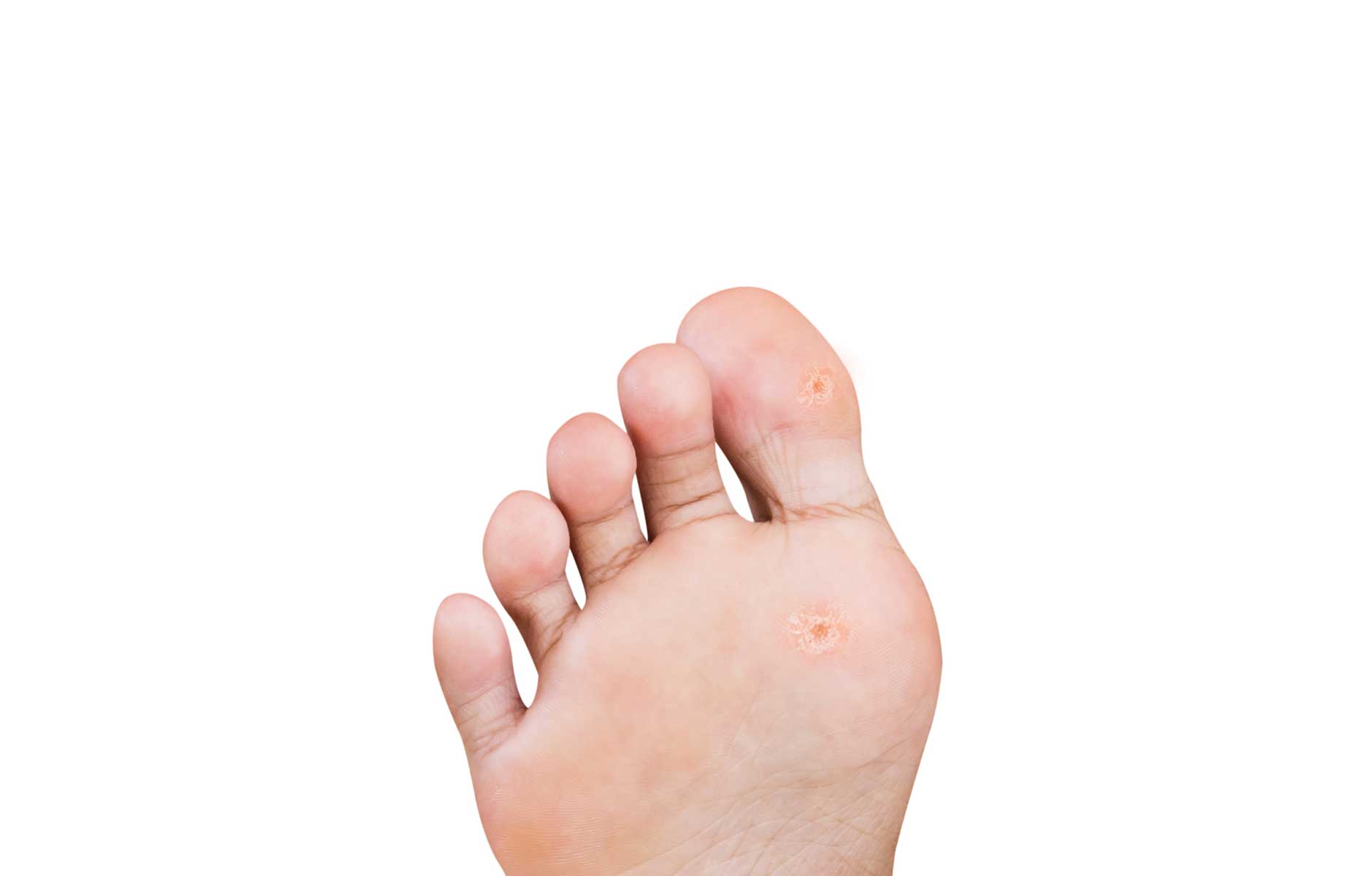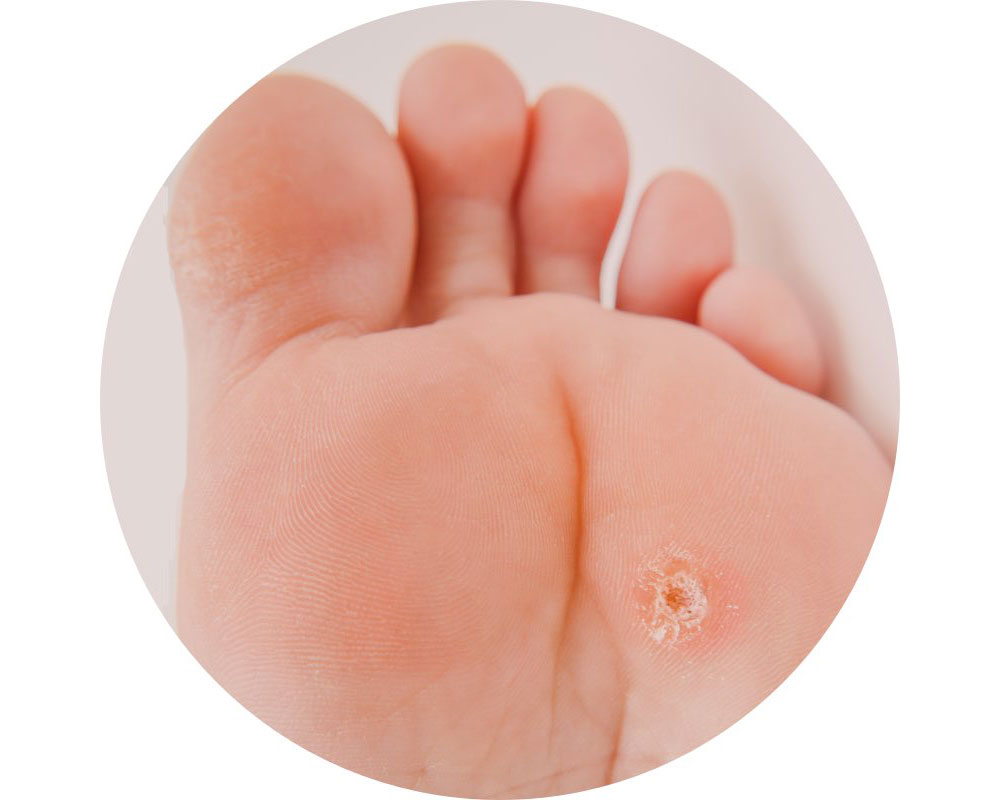Everything you need to know about warts and surgical removal
What causes a wart?
Warts on the feet are common; they are caused by a viral infection involving the human papillomavirus (HPV). Warts on the feet are also known as verrucae or verrucae pedis.
They are very common, can be spread by direct contact from person to person, or as commonly occurs, a small piece of wart tissue with the virus attached is shed in an area where bare feet are exposed.
This maybe in a swimming pool, a shower recess, a changing room, a hotel bathroom and anywhere really where bare feet are exposed.
Wet environments can make it easier for the virus to survive and be transferred, hence the reason why swimming pools or damp shower recesses are a perfect place for warts to be contracted.
What do warts look like?
Warts on the feet can look slightly different to warts in other areas that are not weight-bearing. Warts on the hands or genitals can sit proud of the skin and seem to grow above the level of the surrounding skin.
Warts on the feet are often flat or sit slightly raised above the surrounding skin with a gradual rise. They may have a callus or hard skin over them that can make them look thicker than they are.
This difference occurs as warts on the feet are compressed as they bare weight.
There is often a border to the wart, and if you look close you can notice the ridges of the skin; like fingerprints are pushed aside, and the wart pushes the ridges apart. A corn or callus, for example, can still contain the ridges of the skin and may not have a specific border.
If you look at the wart closely inside the border can have the appearance of a tiny cauliflower.


What if they are discoloured or a colour change occurs?
Warts are typically skin coloured; however, sometimes small dots of blood can be squashed into them form the underlying capillaries. If your lesion is dark coloured, blueish or a colour change occurs it is imperative you contact your podiatric surgeon or GP as soon as possible to ensure it is nothing more sinister.
How do kids get warts?
As mentioned above, warts are spread by contact or from walking on surfaces with bare feet after someone else with a wart has walked. When children start to attend school, they will be exposed to the wart virus when shoes and socks are taken off and perhaps when they commence swimming lessons or swimming in a friend’s pool.
The child may not have been exposed to that strain of the virus and have no immunity to it, and hence it can infect that child’s foot.
Are warts contagious?
Yes, they are a viral infection and hence if exposed you can contract the wart virus. You may start with one wart and then as the virus spreads to the surrounding cells, the wart will often grow larger and can even spread to other parts of the foot and the other foot.
It is common for a person to start with one small wart and end up with multiple warts all over both feet.
Are warts dangerous?
Warts on the feet are not dangerous. If small, they may not even be painful.
Warts are an infection of the skin and do not penetrate the deeper structures.
Do remember that if the colour changes or they rapidly grow to have them assessed in case something more sinister is occurring.
Do warts have roots?
No, they do not. The old belief was that warts have roots and that all these roots need to be removed. This was one of the reasons that some warts were cut and stitched. We now know that this is not the case, and no excision or suturing is required.
The wart can spread outwards and become more extensive and infect a larger area.
What happens if you leave a wart?
There is evidence to show the body can attack the infection and remove the wart. The wart is a viral infection, and it may take the body a long time; however, the body can finally identify the virus and attack it and eradicate the wart.
During a consultation, a patient will be informed this is one of the options. If the wart is not painful, then “wait and see” is an option. Be aware however they may spread in that time.
However, many warts will not go on their own, and it must be borne in mind they can grow and spread in this time.
How to remove warts
How can I remove warts?
There are various options to treat warts;
- Over the counter creams. These typically can be bought at the chemist and contain a weak acid. This will take a long time and will only work on very small warts
- “Acids” Sometimes known as caustics are usually applied by a podiatrist on a weekly bases. Then the burnt wart is trimmed until it is all removed. This is the most common treatment.
- “Freezing”, sometimes known as cryotherapy. This is done by a podiatrist, GP or dermatologist and involves spraying liquid nitrogen onto the wart. This will hopefully gradually kill the wart over a few sprays. Also commonly done.
- This is a new technique that is showing some promising results.
- This was popular approximately ten years ago; however, results were not as good as was hoped and is now often not carried out.
- A method of “scooping” the wart out in one go. It is carried out by podiatric surgeons and some dermatologists.
What is the fastest way to remove a wart?
Curettage is the fastest way. In most cases, the treatment is a one-off procedure carried out under local anaesthetic in the podiatric surgeon’s office.
When should you consider curettage?
Non-surgical treatment such as the acids will, in most cases, be successful and should, therefore, be attempted first. These can take a long time and in some situations, be unsuccessful. Some warts are too big or may involve a potent or virulent strain and will not go.
In this situation, curettage may be a good option. Typically, a curettage is carried out when the non-surgical means have been unsuccessful.

Curettage surgery and recovery
How is wart curettage done?
The curettage procedure involves “scooping” out the wart.
The wart infects only the skin, and therefore there is no need to cut and remove the infected skin. The white fibrous layer demarcating where the wart finishes and the healthy tissue is identified and the wart removed.
Procedure:
- You will be lying down on the examination chair/ bed in the consultation room.
- Most cases, it is done under local anaesthetic. An injection is carried out under the wart to numb the region.
- The foot is scrubbed with an antiseptic wash.
- Once numb the tip of a scalpel is used to mark out where the wart is. Typically, it region approximately 2 mm wider will be curetted to ensure all of the wart is removed.
- Once all the wart is removed, the base is wiped with a chemical called phenol to ensure all wart is killed and cauterise blood vessels.
- The area is again cleaned with more antiseptic.
- Dressed with a large antiseptic dressing.
- The actual procedure takes approximately 15 minutes, and all up you will be in the room for about 45 mins.
- You will need to wear a sandal or thong.
Can it be done under general anaesthetic or sedation?
Yes, it can. The injection under the wart is very quick; however, it can be painful. If you do not want to experience the injection or do not want to be awake while the procedure is carried out, it can be done in the day theatre, on one of Dr Lafferty’s surgery lists in the day hospital. It will not require an overnight stay.
Is wart curettage painful?
No, the quick final application of the phenol has a very handy side effect. It cauterises the nerve endings in the base of the wart and in most cases, this results in NO pain after the procedure. Very occasionally, pain may be experienced; however, if this is the case, it can easily be managed with simple analgesics.
What is involved in the recovery after wart curettage?
A large dressing is applied after the surgery as they tend to bleed after the procedure. It is essential you go home immediately and rest and elevate the foot that day and night.
The large dressing is left in place and kept clean and dry for 3-4 days; however, it can stay on for up to a week if required. While the large dressing is on, you must take it easy; however, you can get around.
You can see the referring podiatrist or GP for dressing changes or see Dr Lafferty.
Once the large dressing is removed, a daily salt soak is advised, and the wound is dressed with a special dressing that is supplied.
It is essential the podiatrist or Dr Lafferty adds a deflective pad to an insole, to allow you to walk with very little pain and allow the wound to heal well.
Once you are at the saltwater soak stage, you can live a reasonably normal life, just avoid any long walks and sports activities.
Typically, it will take approximately two weeks to heal; however, large warts may take longer.
Will warts come back after curettage surgery?
Rarely, however, you will be warned that some warts will survive and come back. This is rare; most will be removed permanently.
What complications can occur?
Wart curettage surgery is very safe, and complications are now rare, although there are certain risks that patients must be made aware of, regardless of the rarity.
The risks of foot surgery are very similar to those risks posed by having other surgery, such as infection and unexpected pain. Infections are very rare
The warts may return. Rare.
A painful scar may develop; however, as the deep layers of the foot are not breach this should not occur and is exceptionally rare.
Bleeding, as mentioned before warts can bleed following curettage and elevation must be strictly adhered to.
More significant warts may take several weeks to heal fully.
Risks associated with surgery are explained to the patient during their pre-operative consultation. You will have every opportunity to ask as many questions as you like during the consultation.
Useful resources:
The Australasian College of Podiatric Surgeons
The American College of Foot and Ankle Surgeons
The Academy of Minimally Invasive Foot and Ankle Surgery
